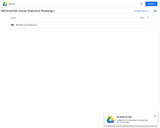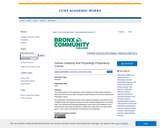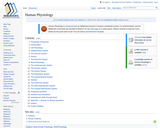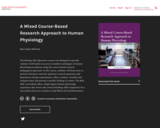
This is a lab manual fo ra human anatomy course.
- Subject:
- Anatomy/Physiology
- Life Science
- Material Type:
- Textbook
- Provider:
- QUT eBooks
- Author:
- Fallon Horstmann
- Katherine Harkin
- Paul Fenn
- Physiology Team
- QUT Anatomy
- Date Added:
- 05/09/2021

This is a lab manual fo ra human anatomy course.

Human Anatomy and Physiology (A&P) 241 is the first class in a two quarter sequence in which human anatomy and physiology are studied using a body systems approach with emphasis on the interrelationships between form and function at the gross and microscopic levels of organization. You can think of this course as An Owneręs Guide to the Human Body. My goal is to help you learn how your body works so that you can explain concepts to others and apply knowledge to novel situations (e.g. make informed decisions regarding your own health and those whom you care about). Youęll also learn how to evaluate scientific research that forms the basis of our understanding of human anatomy and physiology and gain an appreciation for what remains to be discovered. To accomplish these goals requires significant effort from both of us. Although you will need to commit information to memory, I will ask you to focus on learning for understanding and your assessments will reflect this emphasis.

This document contains a list with all the Anatomy and Physiology I expected learning outcomes organized by topics, and grouped into ten units: 1. Introduction to A&P: body plan & organization; 2. Introduction to A&P: homeostasis; 3. The chemical level of organization; 4. Levels of organization: the cellular level of organization; 5. Levels of organization: the tissue level of organization; 6. Support and movement: integumentary system; 7. Support and movement: skeletal system & articulations; 8. Support and movement: muscular system; 9. Regulation, integration, and control: nervous system; 10. Regulation, integration, and control: special senses
Each learning outcome is referred to a section in the textbook "Anatomy and Physiology" by OpenStax: https://openstax.org/details/books/anatomy-and-physiology
The learning outcomes are a derivative work of the "HAPS A&P Learning Outcomes" by The Human Anatomy and Physiology Society: https://www.hapsweb.org/page/AP_Outcomes_home

The overall purpose of this preparatory course textbook is to help students familiarize with some terms and some basic concepts they will find later in the Human Anatomy and Physiology I course.
The organization and functioning of the human organism generally is discussed in terms of different levels of increasing complexity, from the smallest building blocks to the entire body. This Anatomy and Physiology preparatory course covers the foundations on the chemical level, and a basic introduction to cellular level, organ level, and organ system levels. There is also an introduction to homeostasis at the beginning.

The overall purpose of these preparatory course set of learning objectives is to help students familiarize with some terms and some basic concepts they will find later in the Human Anatomy and Physiology I course.
These 40+ learning objectives to prepare for Human Anatomy and Physiology can be downloaded and played in a desktop, or laptop (windows exe file).
The entire course has four parts: Part 1 Part 2 Part 3 Part 4
Each learning objective is followed by a set of multiple choice question similar to those found later in a Human Anatomy and Physiology course.
The organization and functioning of the human organism generally is discussed in terms of different levels of increasing complexity, from the smallest building blocks to the entire body. This Anatomy and Physiology preparatory course covers the foundations on the chemical level, and a basic introduction to cellular level, organ level, and organ system levels. There is also an introduction to homeostasis at the beginning.

Human biology is an interdisciplinary area of study that examines humans through the influences and interplay of many diverse fields such as genetics, evolution, physiology, anatomy, epidemiology, anthropology, ecology, nutrition, population genetics, and sociocultural influences; it is closely related to physical anthropology.

This is a textbook for a course on Human Biology.
![Human Diseases Related to Different Body Systems [Biology]](https://vivaopen.oercommons.org/static/newdesign/images/materials/default-thumbnail-index.png)
This assignment, aligned to LaGuardia Community College's Global Learning Core Competency and Digital Communication Ability, was designed for the laboratory part of Human Anatomy and Physiology I (SCB203) course. The assignment, "Human Diseases Related to Different Body Systems" aims to promote students learning and preparation towards their future major in STEM and in the Allied Health Programs. SCB203, taught by faculty in the Natural Sciences department, is a program-core course for Liberal Arts-Mathematics and Science majors and a key Pre-Clinical course (prerequisite) for future enrollment of students into several Allied Health majors such as Nursing, Occupational Therapy, Physical Therapy, Radiologic Technology, Dietetics, Veterinary Technology, Therapeutic Recreation and EMT/Paramedic Program. It is crucial then that these programs goals and the Human Anatomy and Physiology courses (such as SCB203) align well with and promote the scale up of assignments in the curriculum. The dimensions of the Global Learning Core Competency and Digital Communication Ability rubrics reflected in Human Diseases and Healthcare also run across many courses in the Health Sciences programs; for instance, in the SCO101 course in the Occupational Therapy program and in HTR101 Therapeutic Recreation to help build student learning and professional identities. This assignment in SCB203 can offer the first experience to students to practice on these needed skills and will contribute to students future academic performance in the Health Sciences-related programs.
LaGuardia's Core Competencies and Communication Abilities The assignment was initially developed as part of the Provost Learning Space project on Evidence of Student learning in SCB203 in 2016-17 and has been implemented in all the SCB203 laboratory sections taught by Dr. Gupta since Spring 2017. It entails research by student groups on the etiology, symptoms, treatment/preventive options and global distribution of human diseases related to different body systems, as well as the socio-economic, environmental or genetic factors leading to such distributions. PowerPoint presentations in class (using different digital modalities such as text, images, tables, graphs, citations or hyperlinks), collaborative communication on each other's work via ePortfolio, and submission of simple concept sheets provide an opportunity for students to earn extra credit while revising major concepts pertinent to the final exam. This low-stakes exercise is worth 1% of the total course grade and students have 2 weeks to complete it.

Physiology The word physiology is from the Ancient Greek φυσιολογία (phusiología, "natural philosophy") and it is the study of how organisms perform their vital functions. An example is the study of how a muscle contracts or the force contracting muscles exert on the skeleton. It was introduced by French physician Jean Fernery in 1552. Physiology is built upon a tripod of sciences: physics, chemistry, and anatomy.

These are interactive activities that are based on the OpenStax textbook on Anatomy and Physiology. The majority of definitions have been incorporated into dialogue cards. And the majority of diagrams have been made into interative drag and drop with MCQ and other question types.

This animation describes Intramembranous ossification which is a process of bone formation.

This course introduces students to issues in the field of biomedical ethics, the theoretical tools bioethicists use to analyze them, and methodology for resolving clinical ethical dilemmas.

This text was designed for use in the human osteology laboratory classroom. Bones are described to aid in identification of skeletonized remains in either an archaeological or forensic anthropology setting. Basic techniques for siding, aging, sexing, and stature estimation are described. Both images of bone and drawings are included which may be used for study purposes outside of the classroom. The text represents work that has been developed over more than 30 years by its various authors and is meant to present students with the basic analytical tools for the study of human osteology.

Introduction to Neuroscience is designed for undergraduate students enrolled in introductory neuroscience courses. Specifically, this text targets students enrolled in Introduction to Neuroscience 1 and Introduction to Neuroscience 2 at Michigan State University and contains topics covered in those courses.

This book is a cloned version of KINES 200: Introductory Neuroscience by Peter L.E. van Kan, Ph.D., published using Pressbooks under a CC BY (Attribution) license. It may differ from the original.

Medical Terminology for Healthcare Professions is an Open Educational Resource (OER) that focuses on breaking down, pronouncing, and learning the meaning of medical terms within the context of anatomy and physiology. This resource is targeted for Healthcare Administration, Health Sciences, and Pre-Professional students.

The Biology 256 Laboratory course was designed to provide students with hands-on access to modern techniques in human physiological analyses using the course-based research pedagogical approach. In this course, students will learn how to perform literature searches; generate research questions and hypotheses; design experiments; collect, analyze, visualize and interpret data; and present scientific findings to others. The Biol 256L curriculum offers a high-impact human physiology experience that fosters the critical thinking skills required to be a successful citizen in a modern world filled with misinformation.

This animation describes the process of WBC formation from myeloblast.

In this survey text, directed at those not majoring in biology, we dispel the assumption that a little learning is a dangerous thing. We hope that by skimming the surface of a very deep subject, biology, we may inspire you to drink more deeply and make more informed choices relating to your health, the environment, politics, and the greatest subject that are all of us are entwined in, life itself.

Neuroscience: Canadian 2nd Edition Open Textbook is a comprehensive source that examines the nervous system, neurodegeneration, techniques in studying neuroscience and emerging topics in the field.